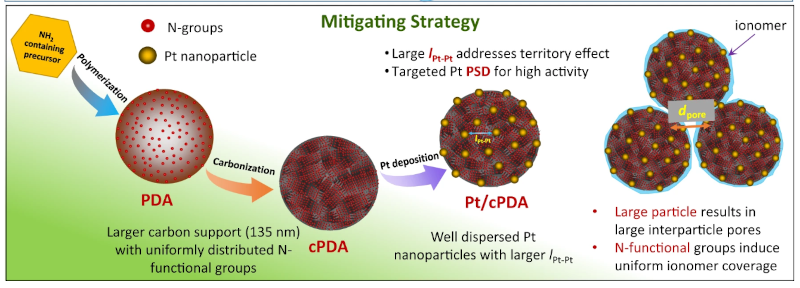A fuel cell is almost like a battery that has replenishable fuel. Instead of charging a battery with an electric current, you recharge a fuel cell with something like hydrogen or you simply consume it from a tank much as an internal combustion engine consumes gasoline. However, fuel cells usually use a catalyst — it isn’t consumed in the reaction, but it is necessary and many fuel cells use platinum as a catalyst which is expensive. But what if you could use less catalyst and get a better result? That’s what researchers in Canada and the US are claiming in a recent paper. The key isn’t how much catalyst they are using, but rather the shape of the catalyst.
Of course, everyone wants to use less of the expensive catalyst but polymer electrolyte fuel cells have had a particular problem where reducing the amount of catalyst used causes a disproportionate drop in cell performance. This new approach uses spherical catalyst support that improves the distribution and utilization of the catalyst.
One of the biggest problems with hydrogen fuel cells, of course, remains the storage of the hydrogen. Toyota has a proposed answer for that. We’ve also seen proposals for storing it in a paste form.
We are always surprised we don’t see more homebrew activity in the area of practical fuel cells. Sure, there’s RACHEL the drone. The last big push we saw was back in 2015, but those projects have either disappeared or suspended further work.
















I did fuel cells for 10 years. I taught a class on fuel cells for 3 years. I still love fuel cells
Then you can tell why everyone loves PEM despite having all sorts of problems, and overlooking SOFC which can burn just about any fuel and generates high grade heat as well.
For the rest of us:
PEM – polymer electrolyte membrane
SOFC – solid oxide fuel cell
*Proton Exchange Membrane
It’s probably because “PEM fuel cells have been shown to be capable of high energy densities up to 39.7 kW/kg, compared to 2.5 kW/kg for solid oxide fuel cells.”
Which is far more of a big deal when the target use case is mobile(automotive) as opposed to stationary(housing).
Yes, and those R/C toy cars enjoy the SOFC energy storage medium,
2.5 kW/kg isn’t too bad.
Electric cars, or lithium-ion batteries in particular, have a specific power up to about half of that, for short periods of time with a full battery.
There’s also the tiny little issue of SOFCs emitting CO2
PEM emits heat and water vapor
Six billion people on the earth, not to mention all the animals (the biomass of ants alone is 5x that of humanity) ALL emit CO2. So take a deep breath (don’t feel guilty about it) and relax.
Second, the PEM “emits only water vapor” if you have a magical, inexhaustable, carbon-zero source of hydrogen. I was under the impression that tge biggest commercial source of H2 is hydrocarbons…that is, oil.
Blah-blah-blag solar… blah blah blah fusion… I get it. But you fight your battles with the army you have, not the army you wish you had.
All that said, I have long been an an advocate for development of fuel cell electric vehicles. The present obsession with rechargeable cars–the ones being rammed down our throats right now to “save the earth,” is not rational, and does’t survive even simple engineering analysis.
SOFCs only emit CO2 if you run them off fossil fuels, and that’s also true for PEMs.
The insistence on zero CO2 at the tailpipe is the main reason why the transport sector cannot decarbonize: forcing battery electric vehicles instead of developing clean synthetic fuels is what’s retarding the whole show. It’s a colossal waste of time.
Watch as politicians start to backpedal on ICE bans, CO2 emission limits, carbon and fuel taxes, when the alternative turns out to be non-viable for their wider constituencies and the effects of “stick but no carrot” policy turns the popular opinion against them.
https://phys.org/news/2022-11-popular-strategies-gasoline-chance.html
SOFCs tend to be harder to implement due to the higher operating temperatures required. Without heat recovery they also have worse (round-trip) efficiency. That plus the lower power density makes them less suitable for automotive applications, which are the most eye-catching. I’ve seen some limited commercial use of SOFCs in stationary applications (i.e. grid storage / backup power).
Fuel cells of vehicles would make more sense if they could be made practical by running on a liquid fuel.
Oh wait they do, DEFCs.